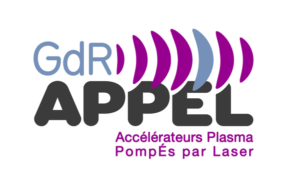Orateur
Description
We examine numerically the processes of magnetic field generation in relativistic femtosecond laser-solid interactions. Our study is motivated by a recent experiment at LOA, whereby the B fields induced in a thin (~20 μm) solid foil by a ∼1019 Wcm−2, ∼30 fs laser pulse were diagnosed via electron deflectometry. In contrast to a previous experiment[1], the ~100 MeV-range probe beam was produced by an auxiliary laser-wakefield accelerator, and injected into the solid foil through its rear (non-irradiated) surface. The mean angular deflection and root-mean-square (rms) spread of the beam electrons after exiting the irradiated foil surface showed nontrivial dependencies on delay time and transverse position with respect to the driving laser pulse.
We compare these measurements with the results of 2D collisional particle-in-cell simulations run under conditions as close as possible to the actual ones. Notably, we take into account the 2D preplasma created by the laser’s pedestal and describe self-consistently the interaction of the probe electrons with the induced plasma fields. Two main B-field generation mechanisms are found to account for the observed electron deflections: (i) the collisionless current filamentation instability[2], which excites strong (>103 T), kinetic-scale fields around the laser spot[3]; (ii) the fountain-like motion of the fast electrons near the plasma-vacuum boundaries, which leads to azimuthal B fields surrounding the laser spot up to ~100 μm radii[4,5].
Our synthetic deflectometry maps reproduce qualitatively the experimental data as regards both the mean and rms deflections. To shed further light on the simulation results, we proceed with a quasistatic approach which enables the respective effects of the small- and large-scale field components to be isolated as a function of the location and time of probing.
References
[1] G. Raj et al., Phys. Rev. Res. 2, 023123 (2020).
[2] A. Bret, L. Gremillet, and M. Dieckmann, Phys. Plasmas 17, 12050 (2010).
[3] J. C. Adam et al., Phys. Rev. Lett. 97, 205006 (2006).
[4] G. Sarri et al., Phys. Rev. Lett. 109, 205002 (2012).
[5] W. Schumaker et al., Phys. Rev. Lett. 110, 015003 (2013).



